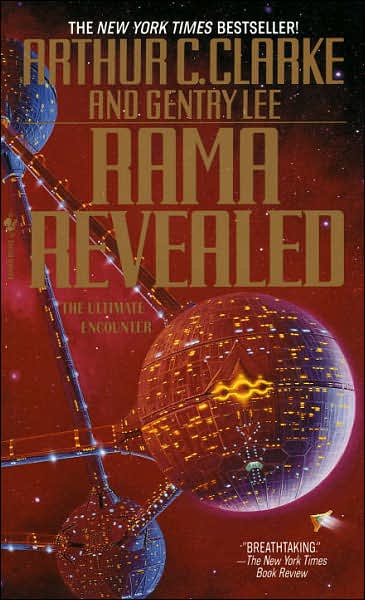

|
| Cover by Stephen Youll |
| RAMA REVEALED Arthur C. Clarke Gentry Lee New York: Bantam Books, January, 1995 |
Rating: 4.0 High |
|||
| ISBN-13: 978-0-553-56947-? | ||||
| ISBN-10: 0-553-56947-3 | 602pp. | SC | $5.99 | |
One of the great things about Arthur C. Clarke's fiction is its intimations of a controlling purpose to life, the universe and everything. Call it destiny or deity, it is there in most of his work. In "Rescue Party", for example, the rescuers speak of "unknown powers" who "folded the time barrier around the universe." Childhood's End goes a little farther, positing an "Overmind" that tells the star-travelling Overlords what it wants done, and they doeth it. But Clarke was always careful not to get too detailed about this ultimate authority. In Childhood's End we see that the Overmind has awesome powers,1 but we learn next to nothing about its nature or purpose. That's the way it should be.
A Rendezvous with Rama is one of Clarke's masterpieces.2 However, it avoids the teleology entirely.3 In the year 2130, when humanity has developed the ability to routinely travel the solar system, an object is detected hurtling inward toward the Sun. Telescopic observations show it to be a giant cylinder — clearly artificial. Of course an expedition is mounted. They find a way inside and encounter many mysteries. The novel's final sentence tantalizes us with the implicit promise that we will learn more about these mysteries.
Indeed we have. The Rama concept, in fact, has become a cottage industry for B. Gentry Lee, a spacecraft engineer at NASA's Jet Propulsion Laboratory. He and Clarke collaborated on four novels: Cradle, Rama II, The Garden of Rama, and Rama Revealed. Lee wrote Bright Messengers by himself; it was published in 1995.
Reaction to these collaborative Rama novels is very much a mixed bag. I have heard that many people don't like them at all.4 I was prepared to dislike this one, but having read it I cannot. It tells an engrossing tale which holds together pretty well, and the characters and environments are well-conceived. Its main shortcoming is that it comes down too heavily on the religious aspect. Near the end of the book its main character, Nicole, meets St. Michael, who tells her that the Nodes and the various spacecraft are part of a system feeding data to Prime Monitors which God (he uses that name) introduced into our universe at the moment of the Big Bang.5 God's aim is to discover the factors which produce a perfectly harmonious universe. I knocked the book's rating down two notches because Gentry Lee (a Catholic, who did most of the writing) skated too close to doctrine for my taste. There are also minor continuity errors, detailed on my Errata page. The bottom line: It's a workmanlike but not exceptional novel.

 To contact Chris Winter, send email to this address.
To contact Chris Winter, send email to this address.